You know that feeling when your content calendar is staring back at you with blank spaces and you’re out of ideas? Between trying to hit the right tone, keep every post fresh, and still sound like you, social media can feel like a treadmill.
AI prompts for social media are changing the game. The right prompt doesn’t just generate a post—it sparks ideas, keeps your brand voice consistent, and helps you experiment boldly. In a world where what makes you stand out is less about having tools and more about knowing how to use them, mastering prompt writing is your secret weapon.
In this article, you’ll discover how to craft AI prompts that drive real results: templates tailored to different platforms, prompt frameworks that ensure engagement, mistakes to avoid, and plenty of sample prompts you can plug in today.
Create, schedule, and optimize social posts with powerful AI tools
TL;DR
- AI prompts translate strategy into publish-ready posts faster and with greater consistency.
- Strong prompts include goal, audience, platform, tone, and constraints to avoid generic output.
- Use data to guide prompting: tie each objective to specific metrics and iterate based on results.
- Balance speed with authenticity by editing for brand voice and adding human stories.
- Avoid common pitfalls: vague asks, one-size-fits-all prompts, overstuffed instructions, and skipping review.
What Are AI Prompts for Social Media?
AI prompts for social media are short, structured instructions you give to a generative AI tool to produce content that aligns with your goals, voice, and audience.
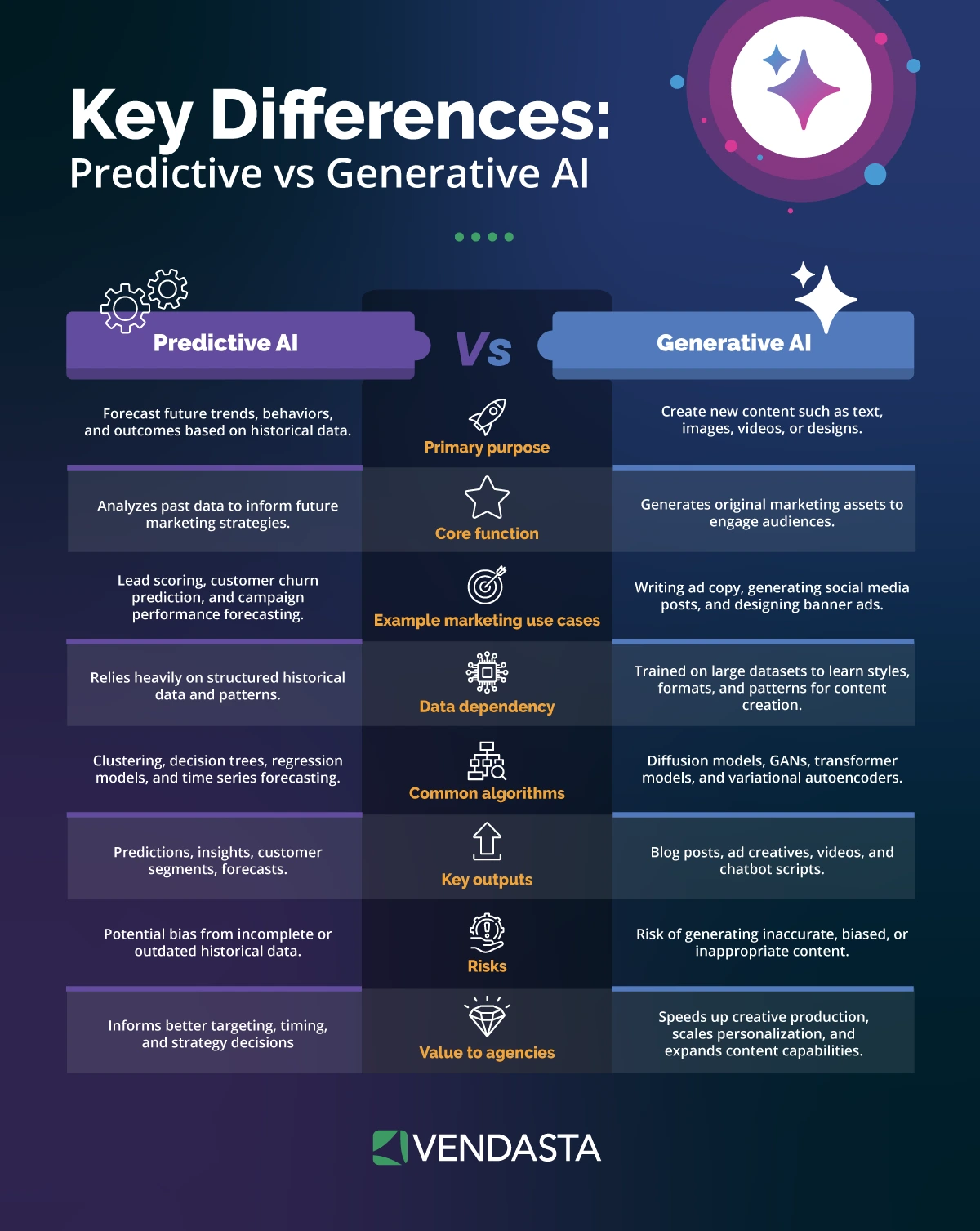
Think of them as the creative spark that guides AI—without a good prompt, the output is often generic. With the right one, you get content that is engaging, brand-consistent, and ready to post.
At their core, AI prompts help you:
- Generate fresh post ideas when you feel stuck.
- Save time by creating captions, hashtags, or ad copy in seconds.
- Maintain a consistent tone across different platforms.
- Adapt one idea into multiple formats (tweets, reels, LinkedIn posts, etc.).
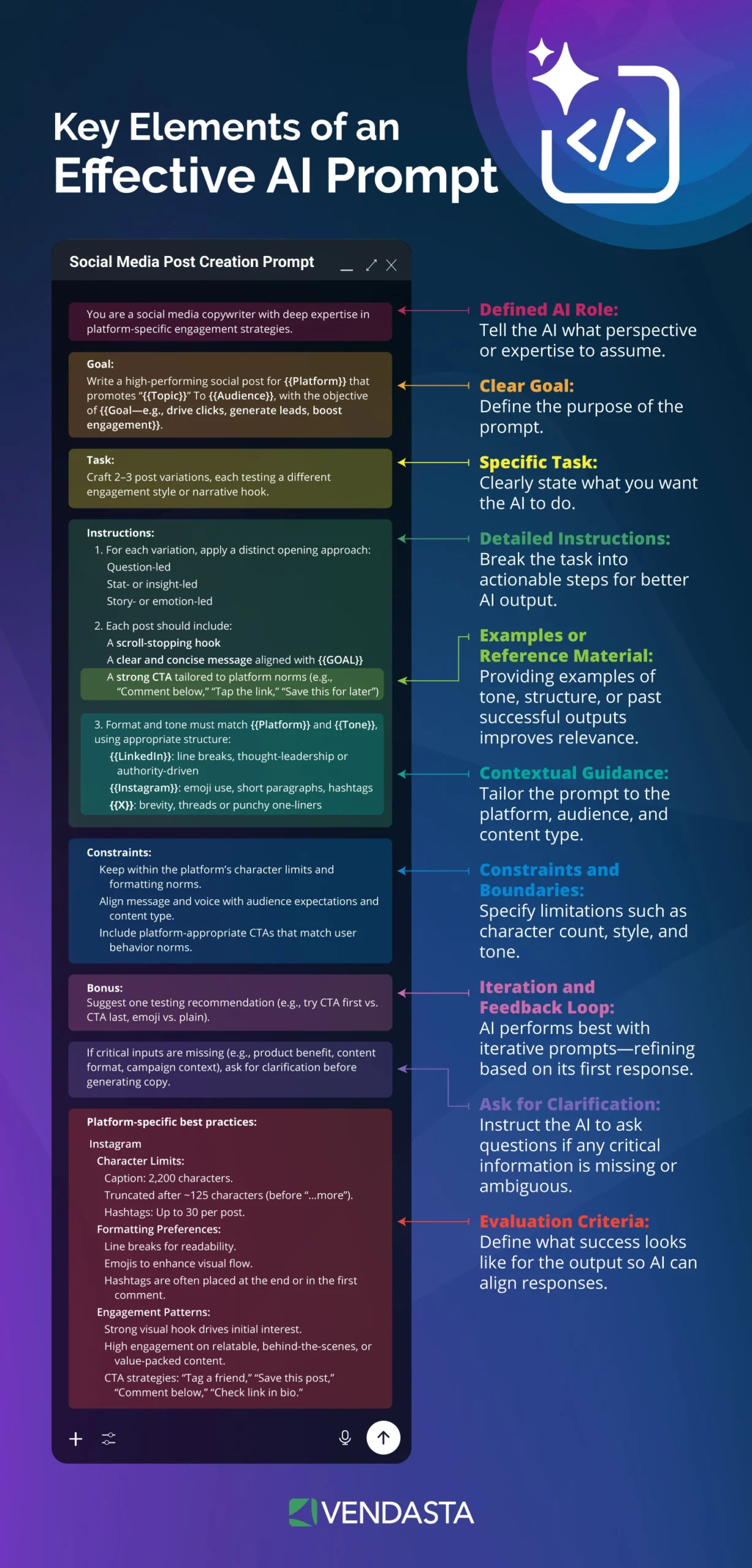
AI tools are widely available, but the differentiator is how you prompt them. In other words, success doesn’t come from having AI at your fingertips, but from learning how to talk to it effectively.
Benefits of Using AI Prompts for Social Media Marketing
AI prompts for social media can transform how you approach social media marketing.
By mastering AI prompting, you unlock efficiency, creativity, and consistency that are hard to achieve manually.
Key Benefits
- Time efficiency: Prompts allow you to generate captions, ad copy, or hashtag sets in seconds, freeing up time to focus on strategy and engagement.
- Consistent brand voice: Well-crafted prompts ensure that every post sounds like your brand, whether it’s playful on Instagram, professional on LinkedIn, or conversational on TikTok.
- Scalable content creation: Instead of struggling to fill a content calendar, prompts let you repurpose ideas across multiple platforms, producing more content without more effort.
- Creative inspiration: Prompts can spark new campaign ideas, uncover trending formats, and break through creative blocks, helping your posts stand out in crowded feeds.
- Improved engagement: By prompting AI with audience-specific details, you can tailor content to resonate with your ideal followers—boosting likes, shares, and comments.
- Data-driven adaptability: AI tools can be prompted to analyze past post performance and suggest improvements, allowing you to refine your messaging continuously.
Many businesses use AI tools, but few know how to maximize them. The real advantage comes from learning how to engineer prompts that produce results unique to your brand.
When your competitors are posting generic AI-generated captions, your customized prompts ensure your voice and strategy shine through.
How to Write Effective AI Prompts for Social Media
Writing effective AI prompts for social media is less about complexity and more about clarity. A good prompt gives the AI enough context to deliver content that feels on-brand and audience-ready.
Steps to Craft Strong Prompts
- Start with context: Tell the AI what the post is for—platform, audience, and purpose. Example: “Create a tweet announcing a product launch for eco-conscious consumers.”
- Define the tone and style: Be explicit about whether you want the content to sound playful, professional, witty, or empathetic. Example: “Write an Instagram caption in a fun, lighthearted tone.”
- Specify the format: Indicate whether you need a caption, headline, carousel idea, or ad copy. This helps the AI match your intended use case.
- Include key details: Provide product names, offers, hashtags, or calls to action. Example: “Draft a Facebook ad headline promoting 20% off summer shoes with a call to shop now.”
- Limit or expand length: Guide the AI on word count, whether it’s a short TikTok caption or a longer LinkedIn thought-leadership post.
Why Prompting Skills Matter
AI can generate content quickly, but the quality depends on how you frame the request. Strong prompts act like mini creative briefs—giving the AI the structure it needs to produce content that saves you time while staying authentic to your brand.
12 Best AI Prompts for Social Media
Social media managers often juggle multiple platforms. The key is having prompts that adapt easily to each one.
Below are 12 prompts designed to save time, inspire creativity, and keep your brand voice consistent.
- “Write a carousel caption that tells a 3-part mini story: the problem, the solution, and the transformation—ending with a CTA to save or share.”
- “Generate 3 reel script ideas using trending sounds that highlight customer struggles and how our product solves them.”
- “Draft a thought-leadership post where the opening line challenges a common industry myth, followed by insights and a question to spark discussion.”
- “Write a short case study post framed as a ‘before-and-after’ story, keeping the tone authoritative yet approachable.”
TikTok
- “Suggest 5 hook lines for a TikTok video that explains a boring topic in a fun, relatable way (using humor or exaggeration).”
- “Write a script for a 15-second TikTok challenge that invites users to duet or stitch their own version.”
Twitter / X
- “Generate a punchy tweet that uses a surprising stat as the hook, followed by a witty one-liner CTA.”
- “Write a 4-part thread that breaks down a complex process into simple, actionable steps.”
- “Create a community post that invites followers to share their first experience with our product—include a playful CTA like ‘Drop your story below 👇.’”
- “Draft a milestone celebration post (e.g., reaching 10,000 customers) that highlights gratitude and encourages comments of support.”
Cross-Platform
- “Write 3 variations of a customer testimonial post: one emotional, one humorous, and one authority-driven.”
- “Generate a behind-the-scenes content idea that can be adapted into an Instagram story, LinkedIn update, and TikTok short.”
Step-by-Step Guide: How to Use AI Prompts for Social Media
AI prompts for social media work best when they’re structured, intentional, and tested over time. Here’s how to make the most of them.
1. Choose the Right AI Tool
When evaluating AI tools for social media, run through this checklist to make sure you’re selecting one that fits your workflow and goals:
- Does it integrate with your content calendar, CRM, or publishing platform?
- Can you adjust tone, style, and voice for different audiences?
- Does it provide platform-specific features (e.g., hashtags for Instagram, threads for X)?
- Can it generate both short-form content (captions, ads) and long-form content (blogs, LinkedIn posts)?
- Is there an option to test or trial the tool before committing?
- Does it offer analytics or insights to improve future content?
- Is the interface user-friendly enough for your team to adopt quickly?
Choosing the right tool is the foundation of success. Check off these boxes before you dive into prompt writing.
2. Define Your Goal
AI works best when you know what you want. Align goals with metrics and strategy.
Goal: Increase reach
- Metrics to track: impressions, follower growth, hashtag performance, post shares, video views.
- Prompt strategy: ask AI to generate captions with trending hashtags, create shareable content ideas, or draft hooks designed to capture attention quickly.
Goal: Boost engagement
- Metrics to track: likes, comments, shares, saves, click-through rates on posts.
- Prompt strategy: instruct AI to create posts that include questions, polls, or calls for user participation.
Goal: Drive website traffic
- Metrics to track: link clicks, landing page sessions from social, bounce rate, and average time on page.
- Prompt strategy: prompt AI to write compelling CTAs, teaser captions, or headline variations that encourage clicks.
Goal: Generate leads
- Metrics to track: form fills, newsletter sign-ups, gated content downloads, and demo requests.
- Prompt strategy: use prompts that highlight offers, emphasize urgency, or position the brand as a trusted authority.
Goal: Increase conversions
- Metrics to track: purchases, add-to-carts, conversion rate, cost per acquisition.
- Prompt strategy: craft prompts that generate persuasive ad copy, emphasize benefits, or reduce buyer hesitation with FAQs and testimonials.
Goal: Strengthen brand loyalty
- Metrics to track: repeat engagement from existing followers, branded hashtag usage, customer testimonials, sentiment analysis.
- Prompt strategy: ask AI to generate appreciation posts, spotlight loyal customers, or create behind-the-scenes content that builds trust.
Goal: Position as a thought leader
- Metrics to track: shares of educational content, mentions in industry discussions, follower growth among professionals.
- Prompt strategy: instruct AI to draft insights, create mini case studies, or generate tips that showcase expertise.
3. Add Context to Your Prompt
AI thrives on details:
- Always include the platform and audience in your prompt. Example: “Write a playful Instagram caption for Gen Z.”
- Add campaign context: launches, seasonal events, or promotions help the AI tailor content.
- Think about pain points or desires your audience has, and build them into the prompt for relevance.
4. Specify Tone and Style
The same message can land differently depending on tone:
- Define tone with adjectives (witty, professional, inspirational, bold).
- Keep your brand voice guide handy and translate it into prompt instructions.
- For multi-platform strategies, adapt tone per channel: professional on LinkedIn, casual on TikTok, inspiring on Instagram.
5. Refine with Details
Adding specifics prevents generic results:
- Include product names, discount details, or hashtags in your prompt.
- Ask for examples, lists, or frameworks instead of broad answers.
- Use modifiers like “limit caption to 15 words” or “include 2 emojis” to get tighter results.
6. Generate Multiple Variations
AI can create dozens of ideas in seconds—use that advantage:
- Request 3–5 variations of each prompt to compare.
- Use one version for organic posting and another for ads.
- Keep the best-performing variations in a swipe file for future inspiration.
7. Edit and Humanize
AI gets you 80% of the way—your job is the final 20%:
- Infuse personal anecdotes, inside jokes, or niche industry language.
- Adjust phrasing so it feels natural to your brand voice.
- Always fact-check: AI may invent stats or misinterpret context.
8. Test and Analyze
Strong prompts evolve through iteration:
- Track engagement metrics like comments, saves, shares, and click-throughs.
- Compare AI-generated posts against human-written ones for performance insights.
- Refine prompts based on data. For instance, if posts with questions drive more engagement, start prompting AI to generate question-based captions.
100+ Free AI Prompts for Social Media Marketers
If you’re ready to take the guesswork out of content creation, we’ve put together a resource designed specifically for you.
Our free ebook, 100+ AI Prompts Every Marketer Needs, is packed with ready-to-use prompts that help you generate scroll-stopping content in seconds.
Inside, you’ll find prompts tailored for:
- Post creation with multiple variations and engagement styles.
- Social media contest promotion posts with clear CTAs and tone options.
- Hashtag suggestion frameworks grouped by primary, secondary, and branded categories.
- Comment engagement and reply templates to keep conversations authentic.
- Audience interaction prompts for polls, questions, and challenges.
- Promotional post prompts designed to drive conversions across platforms.
Whether you’re struggling with creative blocks or simply want to speed up your workflow, this guide gives you plug-and-play prompts you can adapt instantly to your brand voice.
Download the free ebook here: 100+ AI Prompts Every Marketer Needs
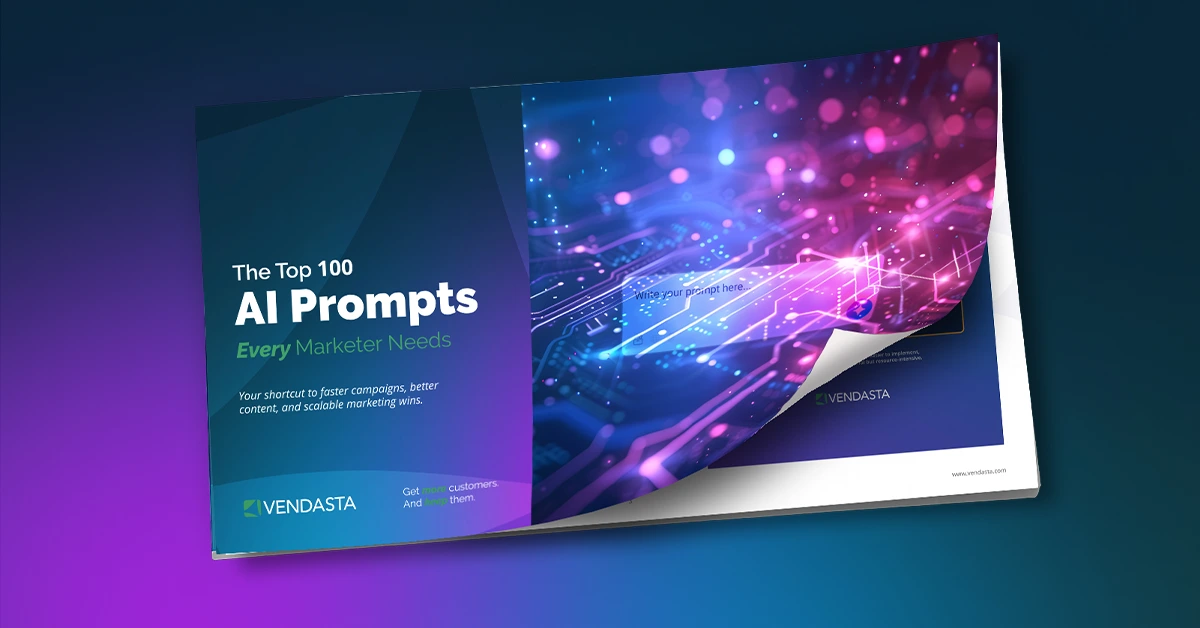
How to Balance AI Prompts With Authentic Brand Voice
AI prompts for social media can help you scale social media content quickly, but speed means nothing if your posts feel generic.
The real value lies in blending AI-generated efficiency with the unique voice your audience already trusts. Here’s how to strike that balance.

1. Start With a Brand Voice Guide
AI only knows what you tell it. Document your brand’s tone, personality traits, and non-negotiable language choices. Then, translate these into your prompts. Example: “Write a LinkedIn post in a confident but approachable tone, avoiding jargon.”
2. Add Human Touchpoints
AI drafts are a first step, not the final product. Always:
- Infuse personal stories, customer spotlights, or cultural references.
- Adjust phrasing to sound natural and conversational.
- Swap out generic CTAs for ones your brand actually uses.
3. Be Specific in Your Prompts
The more detail you give, the more on-brand the output. Include:
- Audience descriptors (e.g., “eco-conscious millennials” vs. “general customers”).
- Desired emotion (playful, authoritative, empathetic).
- Platform rules (hashtags for Instagram, brevity for X, professional tone for LinkedIn).
4. Create a “Do and Don’t” List for AI
Set boundaries so your content doesn’t drift off-brand. For example:
- Do: Use humor sparingly.
- Don’t: Overuse emojis or all caps.
- Do: Highlight customer success stories.
- Don’t: Make exaggerated claims.
5. Always Edit for Authenticity
AI-generated posts should go through human review before publishing. A quick edit ensures the tone feels true, the facts are accurate, and the content reflects real brand values.
6. Test and Learn
Track engagement to see which balance works best. If AI-generated posts feel too polished and underperform, adjust prompts to include more storytelling. If they perform well, build on those frameworks.
Avoid These Common AI Prompt Mistakes in Social Media
AI prompts for social media can supercharge your social media workflow—but only if they’re crafted thoughtfully.
Many marketers fall into common traps that lead to bland, off-brand, or underperforming posts. Here are the mistakes to avoid and how to fix them.
1. Being Too Vague
Mistake: Prompts like “Write a post about our new product” often result in generic copy.
Fix: Add details about audience, tone, and goal. Example: “Write a playful Instagram caption promoting our eco-friendly water bottle to college students, with a CTA to check the link in bio.”
2. Ignoring Platform Nuances
Mistake: Using the same prompt for every platform.
Fix: Tailor prompts to formatting and engagement styles. A LinkedIn post should read like thought leadership, while a TikTok caption should be short, playful, and trend-aware.
3. Overloading with Instructions
Mistake: Stuffing too many directions into a single prompt confuses the AI.
Fix: Focus each prompt on one main goal. If you need variations (e.g., ad copy + hashtag set), break them into separate prompts.
4. Forgetting the Audience
Mistake: Writing prompts without considering who you’re talking to.
Fix: Always include audience descriptors in your prompt—age, interests, or pain points—so the AI tailors messaging appropriately.
5. Neglecting Brand Voice
Mistake: Letting AI output dictate tone without adjustment.
Fix: Embed voice cues into prompts (“professional but approachable”) and always edit for consistency with your brand’s style guide.
6. Skipping Human Review
Mistake: Posting AI copy without edits. This risks factual errors, awkward phrasing, or brand misalignment.
Fix: Treat AI as a first draft. Layer in brand personality, check accuracy, and refine for clarity.
7. Not Testing or Iterating
Mistake: Sticking with the same prompts regardless of performance.
Fix: Track which AI-generated posts drive engagement, clicks, or conversions, then refine prompts to repeat what works.
8. Using AI as a Crutch
Mistake: Relying solely on AI for creativity.
Fix: Combine AI’s speed with your team’s ideas. Use prompts for inspiration, but infuse human stories, experiences, and insights that AI can’t replicate.
AI Trends Transforming Social Media Content Creation
AI isn’t just a tool for quick captions anymore—it’s reshaping how marketers plan, produce, and optimize content across every platform to meet the top customer expectations.
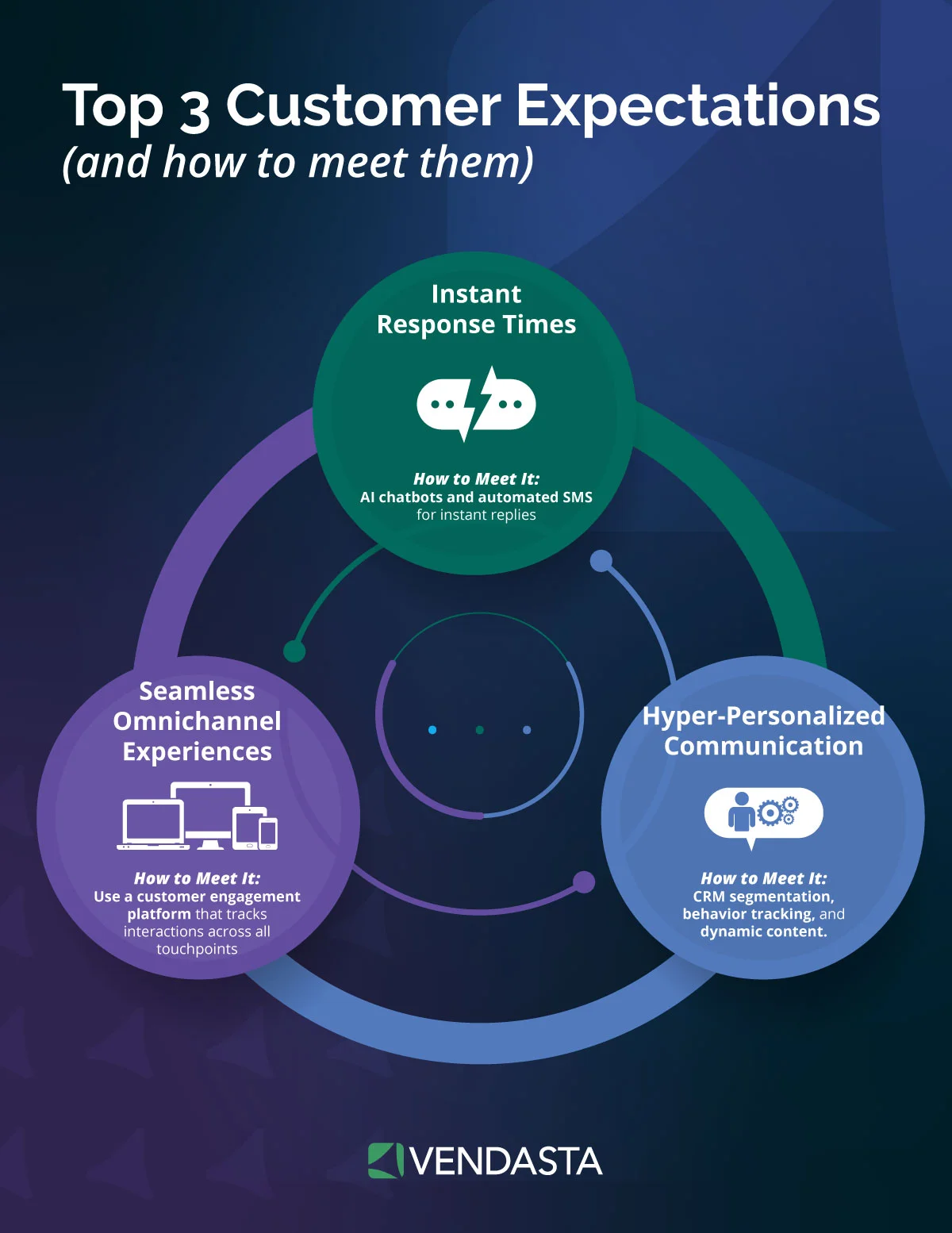
Here are the key trends you need to know if you want to stay ahead of the curve.
1. Hyper-Personalized Content at Scale
AI can analyze audience data to create posts that feel one-to-one, even when reaching thousands.
Marketers now use prompts that incorporate customer segments, behaviors, and preferences to deliver personalized experiences that boost engagement.
2. Smarter Visual + Copy Pairing
AI-powered design tools can generate images, videos, and even carousel graphics that align with copy generated from prompts.
This means faster campaign creation without sacrificing consistency between visuals and messaging.
3. Real-Time Trend Detection
AI tools can scan social conversations, hashtags, and trending audio clips, then suggest prompts tailored to what’s hot right now.
Instead of reacting late, brands can join the conversation at its peak.
4. Conversational Engagement with AI
AI isn’t limited to posts—it’s also shaping replies, DMs, and comment management.
Prompts can now guide AI to craft authentic responses that keep community interactions on-brand and timely.
5. Performance-Driven Prompting
Marketers are increasingly tying prompts to data insights.
For example: “Write 3 ad variations emphasizing benefits, since our last campaign showed features-focused posts underperformed.”
This trend merges AI creativity with analytics.
6. Cross-Platform Repurposing
AI can take one idea and reframe it for multiple platforms.
A long LinkedIn thought-leadership post can instantly become a short X thread, a TikTok script, and an Instagram carousel, all guided by prompts designed for each channel.
7. AI-Powered A/B Testing
Instead of manually writing dozens of variations, AI can generate them instantly.
Marketers then test which hooks, CTAs, or formats perform best, feeding those learnings back into future prompts.
How Vendasta Automates Social Media Marketing With AI
Keeping up with social media demands can feel endless—between ideation, scheduling, engagement, and analysis.
Vendasta simplifies the process by combining automation with AI-driven creativity, helping businesses scale content without sacrificing quality.
At the center of this is Vendasta’s Social Marketing tool, built to generate high-performing social media posts in seconds.
With the help of an AI Content Creator, instead of starting with a blank page, you can:
- Input a topic, product, or campaign goal.
- Generate multiple caption variations tailored to each platform.
- Automatically adapt tone and format for LinkedIn, Instagram, Facebook, TikTok, and X.
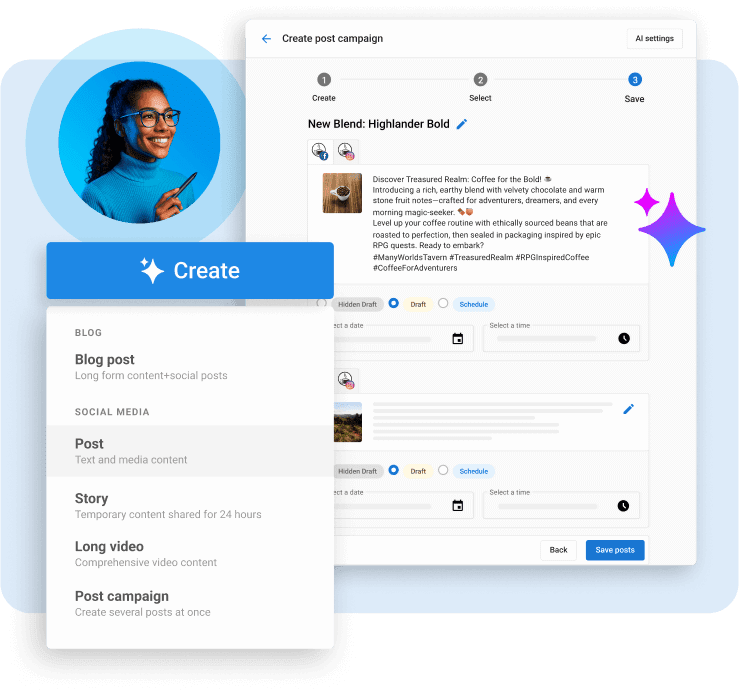
This ensures that every post is consistent with your brand voice while still optimized for platform-specific engagement.
Vendasta’s social media management software streamlines the entire social marketing cycle:
- Scheduling & Publishing: Auto-schedule AI-generated posts to go live at the right times.
- Engagement: Monitor and respond to comments, reviews, and messages in one dashboard.
- Analytics & Optimization: Track what’s working and refine prompts or strategies based on real-time performance data.
Vendasta’s AI-powered automation removes repetitive tasks so you can focus on building client relationships, testing new strategies, and scaling campaigns confidently.
Turn AI Prompts Into Social Media Performance
AI prompts for social media are the fastest path from blank calendar to on-brand, high-performing posts—but the real advantage comes from how you engineer them.
When you give AI clear goals, rich context, and platform-specific guidance, you produce content that is timely, useful, and unmistakably yours.
Pair that with disciplined iteration, such as testing hooks, CTAs, and tones, and your social feeds become a reliable engine for reach, engagement, and revenue.
If you want a head start, grab the free 100+ prompt pack and plug them into your workflow. When you are ready to scale production, scheduling, engagement, and reporting from one place, Vendasta’s AI customer acquisition and engagement platform makes it effortless.
Schedule a free demo to see how Vendasta can streamline your entire social media workflow and turn prompts into performance.
AI Prompts for Social Media FAQs
1. What are AI prompts for social media?
AI prompts are short, structured instructions that guide generative tools to create platform-ready posts, captions, hooks, or hashtag sets. Clear prompts specify audience, goal, tone, and format so outputs are on-brand, engaging, and fast to publish.
2. How do I write effective prompts that match my brand voice?
Include platform, audience, objective, tone, length, and any must-use details (offer, CTA, hashtags). Add “do/don’t” rules and an example of your style. Ask for multiple variants, then human-edit for authenticity and accuracy before scheduling.
3. Do I need different prompts for each platform?
Yes. Platform rules vary: LinkedIn favors value-led paragraphs, Instagram needs punchy captions and hashtags, TikTok benefits from hooks and script beats, and X prefers concise takes or threads. Tailor prompts to length, features, and engagement mechanics.
4. How can AI prompts improve engagement and post saves?
Prompt for audience pain points, questions, or “how-to” frameworks. Request hooks, scannable structure (lists, emojis, line breaks), and a conversation-starting CTA. Ask AI to propose 3–5 angles, then A/B test to learn which hooks drive comments and saves.
5. How does Vendasta help me generate and schedule posts from prompts?
Vendasta’s AI Content Creator turns your brief into platform-specific captions, suggests hashtags, and outputs multiple variations. You can schedule directly, monitor engagement, and refine prompts using built-in analytics—streamlining ideation, publishing, and optimization in one place.
6. What’s a good prompt template for repurposing one idea across channels?
Use a “core idea + channel adapters” template:
“Turn this idea: [summary] into: 1) LinkedIn post (150–220 words, authoritative), 2) Instagram caption (≤120 words + 8–12 hashtags), 3) TikTok hook + 20-second script, 4) X thread (4 tweets), each with tailored CTA.”
7. Can prompts help with social proof and UGC?
Absolutely. Prompt AI to draft outreach DMs, testimonial request scripts, or caption frameworks that spotlight customer quotes. Also, ask for UGC brief templates: required shot list, tone, do/don’ts, and disclosure lines. Then, adapt per platform for compliance and clarity.
8. How do I keep AI outputs from sounding generic?
Feed context. Provide brand voice traits, sample copy to mimic, audience vocabulary, banned phrases, and niche references. Ask for “3 bold, non-generic angles,” require specificity (numbers, examples), and instruct AI to remove clichés and filler before returning options.
9. Can Vendasta optimize prompts with performance data?
Yes. Vendasta aggregates campaign metrics and highlights which hooks, formats, and CTAs win by platform. Use those insights to refine future prompts automatically—e.g., “Prioritize problem-solution hooks; emphasize benefits over features; keep captions under 90 words on Instagram.”
10. What are common AI prompt mistakes to avoid?
Being vague, ignoring platform norms, cramming too many asks into one prompt, skipping human edits, and not testing variations. Fix by focusing each prompt on one goal, tailoring by channel, requesting 3–5 versions, editing for voice, and iterating from performance.



